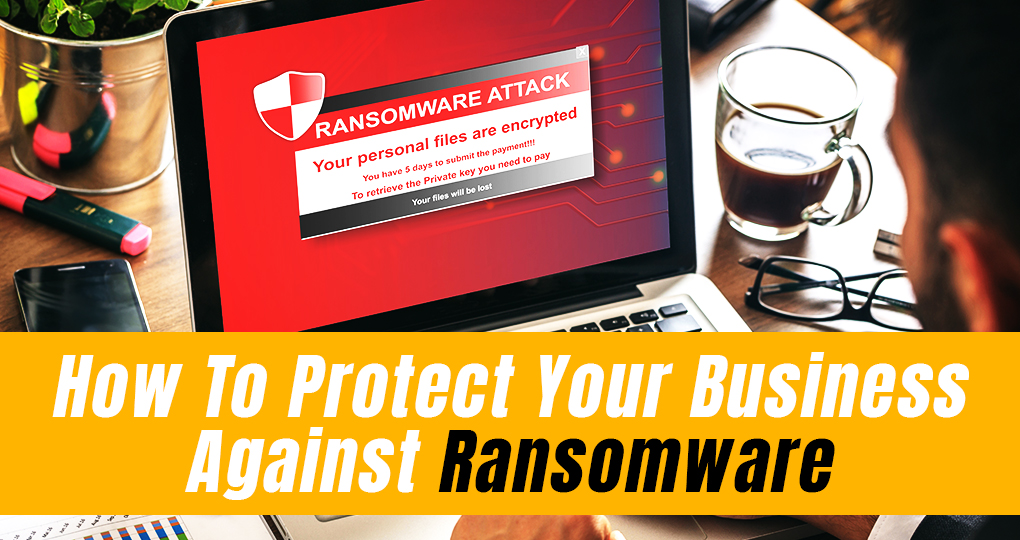4QuartersIT: Blog

How To Protect Your Business Against Ransomware
As explored in our other blog this month, ransomware remains one of the most pervasive and financially damaging cyber threats facing businesses of all sizes. With cybercriminals constantly refining their tactics and targeting organizations across various sectors, the risk of falling victim to a ransomware attack has never been higher.
However, by implementing robust cybersecurity measures and adopting a proactive approach to defense, businesses can significantly reduce their susceptibility to ransomware and safeguard their critical assets.
Understanding Ransomware
Ransomware is a malicious form of software designed to infiltrate computer systems and encrypt files or lock users out of their devices, rendering their data inaccessible. Essentially, it holds the victim’s data hostage, demanding a ransom payment in exchange for the decryption key needed to unlock the files. This type of cyberattack has become increasingly prevalent and sophisticated, posing a significant threat to businesses and individuals alike.
Once ransomware infects a system, it typically encrypts files using strong encryption algorithms, making them unreadable without the decryption key held by the attackers. In some cases, ransomware may also lock users out of their devices entirely, displaying a ransom note demanding payment to regain access. The attackers often demand payment in cryptocurrency, such as Bitcoin, to make it more difficult to trace the transaction back to them.
Ransomware attacks can occur through various vectors, including malicious email attachments, compromised websites, or exploiting vulnerabilities in software or operating systems. Attackers may also use social engineering techniques to trick users into downloading and executing ransomware payloads unwittingly. Once the ransomware is activated, it quickly spreads throughout the victim’s network, encrypting files and causing widespread damage.
Ransomware Defense Best Practices
Regular Software Updates and Patch Management
Keeping software and operating systems up-to-date is crucial for addressing known vulnerabilities that ransomware attackers may exploit. Implement a robust patch management process to ensure that all systems and applications are promptly patched with the latest security updates.
Strong Access Controls
Limiting access to sensitive data and critical systems can help prevent ransomware attackers from gaining a foothold in your network. Implement role-based access controls and least privilege principles to restrict access to only those employees who need it to perform their job duties.
Data Backup and Recovery
Regularly backing up data is one of the most effective defenses against ransomware. Ensure that backups are stored securely and tested regularly to verify their integrity. In the event of a ransomware attack, having a reliable backup can allow you to restore your data without having to pay the ransom.
Email Security
Phishing emails remain a common vector for ransomware attacks. Implement robust email security measures, such as spam filters, antivirus software, and employee training programs, to help detect and mitigate phishing attempts before they can cause harm.
Employee Training and Awareness
Human error is often a contributing factor in ransomware attacks. Provide comprehensive cybersecurity training to employees, teaching them how to recognize phishing attempts, avoid suspicious links and attachments, and report any unusual activity promptly.
Endpoint Security Solutions
Deploying endpoint security solutions, such as antivirus software, intrusion detection systems, and endpoint detection and response (EDR) tools, can help detect and block ransomware attacks at the device level.
Network Segmentation
Segmenting your network into separate zones can help contain the spread of ransomware in the event of a breach. By isolating critical systems and limiting lateral movement, you can minimize the impact of a ransomware attack on your organization.
Incident Response Plan
Develop and regularly test an incident response plan that outlines the steps to take in the event of a ransomware attack. This should include procedures for containing the attack, notifying stakeholders, and coordinating with law enforcement and cybersecurity experts.
You Need A Proactive Approach to Defense
Ransomware attacks pose a significant threat to businesses worldwide, but by taking proactive steps to strengthen your cybersecurity posture, you can reduce the likelihood of falling victim to these insidious attacks.
By implementing a combination of technical defenses, employee training programs, and incident response procedures, you can effectively mitigate the risk of ransomware and protect your business’s critical assets. Remember, when it comes to ransomware, prevention is always better than cure.






